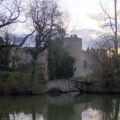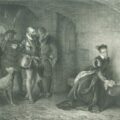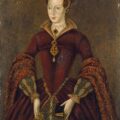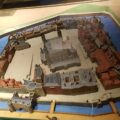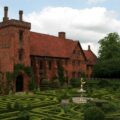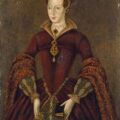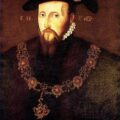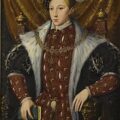
These are the words that Sir Thomas Wyatt the Younger spoke just before the execution. Even when faced with death, he would not implicate Elizabeth, instead he used his scaffold speech to exonerate her and he may well have saved her life.
On the 11th April 1554, Sir Thomas Wyatt the younger was beheaded and then his body quartered, but what had led him to this sticky end? Rebellion is the simple answer.
Wyatt’s Rebellion
Wyatt’s Rebellion, or Wyatt’s Revolt, was an uprising which took place in 1554 and which nearly cost the 21 year old Elizabeth her life. Starkey writes of it:-
“It led to the most dangerous and difficult time of her life when she often feared imminent execution or murder. She even expressed a preference as to how she should die: like her mother, by the sword, rather than by the axe. The rebellion also threatened both Mary’s throne and her life. Which is why, in turn, her rage against Elizabeth was so deep and long-lasting.”
Wyatt had already shown his opposition to Mary when he supported Lady Jane Grey’s claim to the throne after the death of Edward VI – he escaped punishment that time – but he felt compelled to act when he found out about Mary I’s plans to marry King Philip II of Spain.
The plan was to have a series of uprisings in the South, South-West, Welsh Marches and Midlands, and then a march on London to overthrow the government, block the Spanish marriage, dethrone Mary and replace her with Elizabeth, who would marry Edward Courtenay. Unfortunately for Wyatt, other rebel leaders like the Duke of Suffolk (Lady Jane Grey’s father) and the ill-fated Lady Jane Grey (who had nothing to do with the revolt), the whole plan went pear-shaped. It flopped. It failed.
David Starkey, in “Elizabeth”, writes of how the government were alerted to the plots when Sir Peter Carew refused a summons to court and Ambassador Renard heard that a French fleet was assembling off Normandy. Courtenay was interviewed by his mentor Stephen Gardiner and blabbed everything. When the rebels learned that Mary knew of their plans, they did not give up, instead they decided to spring into action. Starkey writes of how three out of the four planned provincial revolts went ahead but were not successful as they “went off at half-cock”. However, Sir Thomas Wyatt did manage to raise a considerable “army” in Kent and Starkey says that “if Wyatt had pressed forward immediately resistance [in London] would probably have collapsed. But he delayed, giving Mary a chance to regain the initiative.”
Wyatt did not take advantage of the desertion of the City whitecoats and the confusion, he let this chance pass him by. Mary took her opportunity and rallied her troops. On the 1st February 1554, Mary gave a speech to the City government in the Guildhall, reminding them that she was England’s queen, that she was “wedded to the realm and the laws”, that she was the true heir to the throne, her father’s daughter, and that she loved her people. She said:-
“On the word of a prince, I cannot tell how naturally the mother loveth the child, for I was never mother of any. But certainly, if a prince and governor may as naturally and earnestly love her subjects, as the mother doth the child, then assure yourselves, that I being your lady and mistress, do as earnestly and tenderly love and favour you.” (From Foxe, Acts and Monuments VI, 414-15, quoted on p133 of Starkey’s “Elizabeth”).
She ended the speech by, according to witnesses, saying that:-
“She never intended to marry out of the realm, but by her council’s consent and advice. And that she would never marry but all her true subjects shall be content.” (from Machyn’s Diary quoted in Starkey).
This rousing speech and half lies worked their magic and won over the people. When Wyatt arrived at Southwark on the 3rd of February, he found it barricaded and guarded. Next, a few days later, he tried entering the City from Kingston and was successful. As they entered the City, the rebels split and although they were now at a disadvantage, having split into groups, a group of them still managed to scare off the Queen’s guards near the Holbein Gate. However, by the time Wyatt and his troops reached Ludgate, Mary’s force had gathered their wits and closed the gates. Mary’s troops far outnumbered the rebels and, with his men surrendering around him and no hope if winning, Sir Thomas Wyatt the Younger surrendered and was captured. Wyatt was taken to the Tower of London.
The End
Not only did Wyatt’s Rebellion lead to his execution and the shadow of the axe hanging over Elizabeth’s neck for many months, it sealed the fate of Lady Jane Grey who had been kept in the Tower since Mary had seized the throne from her in July 1553. On the 12th February 1554, Lady Jane Grey and her husband Guildford Dudley were executed, a tragic end to Lady Jane’s short life and a frightening event for Elizabeth who knew she would be implicated in Wyatt’s Rebellion and who had a very shaky relationship with her half-sister, Mary.
Sir Thomas Wyatt was tried at Westminster Hall on the 15th March. He denied plotting the Queen’s death and would only admit to sending Elizabeth a letter to which she replied (though not in writing) “that she did thank him much for his good will, and she would do as she should see cause.” (Chronicle of Queen Jane and Queen Mary, ed. Nichols, quoted in Starkey). He did not implicate her in any other way. Wyatt was found guilty and sentenced to death but his execution was delayed for a time – it is thought that the Queen’s advisers hoped that Wyatt would still implicate Elizabeth in an attempt to escape execution.
On the 16th March, Mary’s advisers went to see Elizabeth to charge her with involvement in Wyatt’s Rebellion and to tell her that she would be taken to the Tower the next day. If you have read my post “The Imprisonment of Elizabeth”, you will know that Elizabeth used her famous “Tide Letters” as a delay tactic and was not taken to the Tower until the 18th March, Palm Sunday.
On the 11th April 1554, Sir Thomas Wyatt was led out to the scaffold. Starkey quotes Wyatt as saying on the scaffold:-
“And whereas it is said and whistled abroad that I should accuse my lady Elizabeth’s grace and my lord Courtenay; it is not so, good people. For I assure you neither they nor any other now in yonder hold or durance was privy of my rising or commotion before I began. As I have declared no less to the queen’s council. And this is most true.”
Between 9am and 10am, Wyatt’s head was severed from his body, his body quartered and his bowels and genitals burned. His head and the quarters of his body were then taken to Newgate where, according to Starkey, they were parboiled, nailed up and the head placed on a gibbet at St James’s. It is not known what happened to his head, as it disappeared from the gibbet.
Just over a month later, on the 19th May (the anniversary of her mother’s execution), Elizabeth was released from the Tower. She was not to enjoy complete freedom, as she would be kept for a while under house arrest, but she must have been so relieved to be free of the place where her mother had died and where Lady Jane Grey and Wyatt had died. Elizabeth must have said many prayers of thanksgiving.
We cannot be 100% sure that Elizabeth played no part in Wyatt’s Rebellion, as she had had contact with some of the rebels, so it is hard to know whether Wyatt was being truthful when he refused to implicate Elizabeth or whether he was being loyal to the woman who he saw as his true queen.
RIP Sir Thomas Wyatt the Younger.
See yesterday’s post “RIP Sir Thomas Wyatt the Younger” for a video on Wyatt and his rebellion.
Sources
- “Elizabeth” by David Starkey

